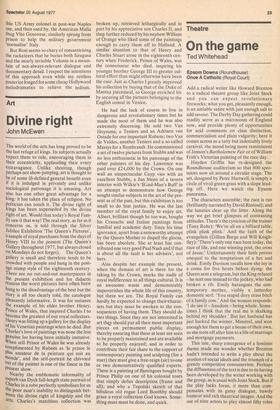Art
Divine right
John McEwen
The world of the arts has long proved to be the last refuge of kings. Its subjects actually expect them to rule, encouraging them in their eccentricity, applauding their every extravagance. Unlike shooting, though perhaps not show-jumping, art is thought to be of some ill-defined general benefit even if it is indulged in privately and unlike sociological patronage it is amusing. Art also has one other great advantage for a king: it has taken the place of religion. No • poltician can touch it. The divine right of kings has been superseded by the divine right of art. Would that today's Royal FamllY saw it that way! The real story, as far as it concerns us, is told through the Silver Jubilee Exhibition 'The Queen's Pictures', a sample of royal purchases from the days of Henry VIII to the present (The Queen's Gallery throughout 1977, but always closed on Mondays do not forget). The Queen's gallery is small and therefore tends to be crowded with people and hung in the postage stamp style of the eighteenth century. There are no out-and-out masterpieces in the present exhibition and for didactic reasons the worst pictures have often been hung to the disadvantage of the best but the story is all too clearly told, the catalogue Pleasantly informative. It was for instance the example of his elder brother Henry, Prince of Wales, that inspired Charles I to become the greatest of our royal collectors. Henry was fitting up a 'gallery for the display of his Venetian paintings when he died. But Charles's love of paintings was none the less genuine for having been initially imitative. When still Prince of Wales he was already complimented by Rubens as 'le prince le Plus amateur de la peinture qui soit au Monde', and the self-portrait he chivvied °Ilt of the painter is one of the finest in the Present show.
Nearby the emblematic informality, of superb van Dyck full-length state portrait of Charles in a robe perfectly symbolises for us the poor man's inability to distinguish betWeen the divine right of kingship and the arts, Charles's matchless collection was
broken up, retrieved lethargically and in part by his appreciative son Charles II, and then further reduced by his nephew William of Orange who liked some of the paintings enough to carry them off to Holland. A similar situation to that of Henry and Charles Stuart arose in the eighteenth century when Frederick, Prince of Wales, was the connoisseur who died, inspiring his younger brother George III to greater cultural effort than might otherwise have been the case. Just as Charles I greatly improved his collection by buying that of the Duke of Mantua piecemeal, so George enriched his by securing all the pictures belonging to the English consul in Venice.
He had the luck of course to live in dangerous and revolutionary times but he made the most of them and he was also extremely discerning. He sold two Van Huysums, a Teniers and an Adriaen van Ostade for one important Rubens; two Van de Veldes, another Teniers and a so-called Massys for a Rembrandt. He commissioned a set of twelve pictures from Stubbs and was no less enthusiastic in his patronage of the other painters of his day. Lawrence was paid over £24,000 by the Crown. On one wall an unspectacular Cuyp vies with an excellent Stubbs, a Jan Steen of a tavern interior with Wilkie's `Blind-Man's Buff' in an attempt to demonstrate how George sought similar subjects in the art of the present as of the past, but this exhibition is too small to do him justice. He was the last member of the royal family to enjoy art. Albert, brilliant though he too was, bought his Cranachs and Italian paintings from familial and academic duty. Since his time ignorance, apart from a noteworthy attempt by the Queen Mother to dispell the gloom, has been absolute. She at least has contributed one very good Paul Nash and if that is about all the fault is her advisers', not hers.
Alas despite her example the present, when the domain of art is there for the taking by the Crown, marks the nadir of royal indifference to all things cultural. It is an awesome waste and demonstrably impoverishes the whole life of this country, but there we are. The Royal Family can , hardly be expected to change their-characters but they must be awoken to the consequences of having them. They should do two things. Since they are not interested in art thy should put all their most important pieces on pefmament public display, thereby ensuring that these at least are seen to be properly maintained and are available to be properly enjoyed; and in order to contribute their fair share to the support of contemporary painting and sculpting (for a start) they musigive a free-reign (sic) to.one or two demonstratively qualified experts. There is a painting of flamingoes bought by Prince Philip on one Of his colonial tours that simply defies description (frame and all); and why a Topolski sketch of that bibulous old rogue Lord Boothby should grace a royal collection God knows. Something must must be done, and quick.































 Previous page
Previous page